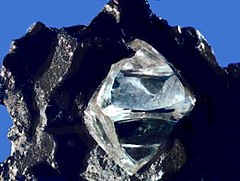
Back Diamant Afrikaans Diamant ALS Diamant AN Daimọn ANN हीरा ANP ألماس Arabic الماز ARZ হীৰা Assamese Diamante AST Almaz Azerbaijani
| Diamond | |
|---|---|
 The slightly uneven eight-sided shape of this rough diamond crystal in matrix is typical of the mineral. Its lustrous faces also indicate that this crystal is from a primary deposit. | |
| General | |
| Category | minerals |
| Formula (repeating unit) | C |
| Strunz classification | 01.CB.10a |
| Identification | |
| Molecular mass | 12.01 g/mol |
| Color | Typically yellow, brown or gray to colorless. Less often blue, green, black, translucent white, pink, violet, orange, purple and red. |
| Crystal habit | Octahedral |
| Crystal system | Isometric-Hexoctahedral (Cubic) |
| Twinning | Spinel law common (yielding "macle") |
| Cleavage | 111 (perfect in four directions) |
| Fracture | Conchoidal (shell-like) |
| Mohs scale hardness | 10 (defining mineral) |
| Luster | Adamantine |
| Streak | Colorless |
| Diaphaneity | Transparent to subtransparent to translucent |
| Specific gravity | 3.52±0.01 |
| Density | 3.5–3.53 g/cm3 |
| Polish luster | Adamantine |
| Optical properties | Isotropic |
| Refractive index | 2.418 (at 500 nm) |
| Birefringence | None |
| Pleochroism | None |
| Dispersion | 0.044 |
| Melting point | Pressure dependent |
| References | [1][2] |
A diamond (from the ancient Greek αδάμας – adámas "unbreakable") is a re-arrangement of carbon atoms (those are called allotropes).
Diamonds have the highest hardness of any bulk (all one type) material. Because of this, many important industries use diamonds as tools for cutting and polishing things. Many of them are clear, but some of them have colors, like yellow, red, blue, green and pink. Diamonds of a different color are called "fancies".
Big diamonds are very rare, and are worth a lot of money. Only 20% of diamonds are fit for jewellery. The other 80% are of lower quality. Those lower quality diamonds are called industrial diamonds, and are used to make things like drill bits and diamond saws. Even if a diamond is not of gem quality, it still has a value because It is very hard.
Cut and faceted diamonds can be attractive hence their use in jewellery. Diamonds are very effective electrical insulators, but also very good conductors of heat. On Mohs scale of mineral hardness, diamonds are scored as 10 (the highest score possible).